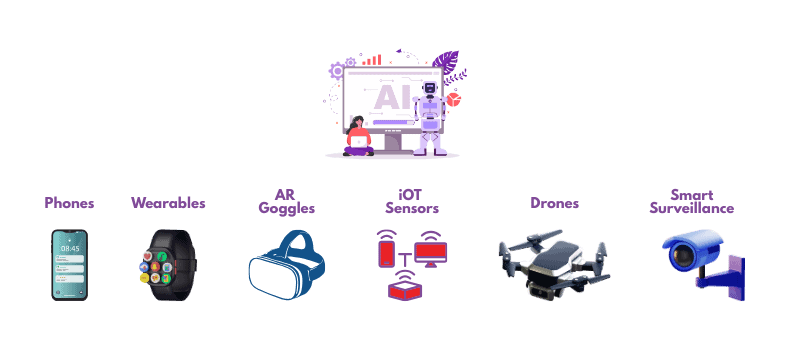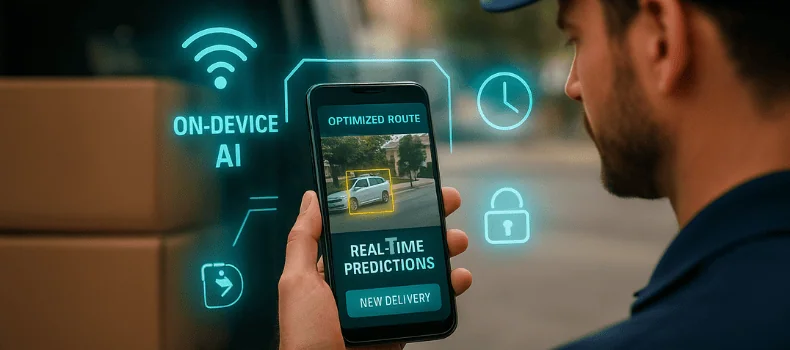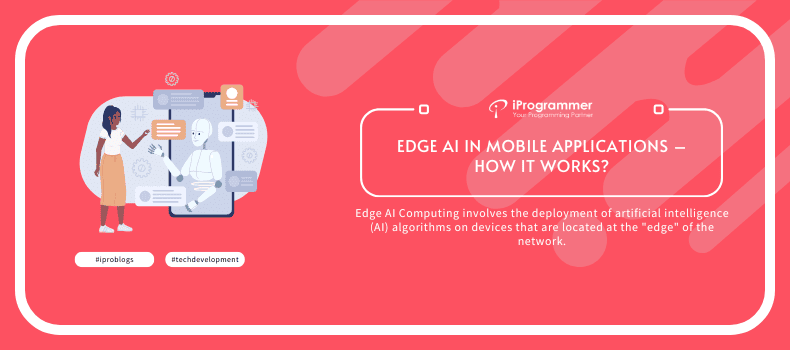Edge AI in Mobile Applications – How It Works
- What is Edge AI Computing?
- Edge AI Devices: Smarter Tools at the Edge
- Real-World Examples of Edge AI in Mobile Applications
- How Edge AI Improves Mobile App Experiences for Enterprises
- Edge AI vs Cloud AI – What’s the Difference, and Why It Matters
- Why Leading Enterprises are Investing in Edge AI Mobile Solutions
- What Enterprises Should Know Before Investing
- Edge AI Security and Privacy Challenges: Risks and Mitigation Strategies
- Measuring ROI and Business Impact of Edge AI in Mobile Apps
- The Future of Edge AI in Mobile: What Lies Ahead
- Conclusion
- How iProgrammer Helps You Create Edge AI Applications
Imagine taking out your smartphone camera and having suggestions to improve your photo immediately, even offline. Or think about voice assistants that can hear and respond to your voice commands quicker, without sending your data to the cloud. Such seamless, real-time experiences are no longer a science fiction concept—they’re made possible by Edge AI Applications running in the background to revolutionize the way we engage with our mobile phones daily.
To vertical industry business leaders and decision-makers, Edge AI is more than a technology buzz term. It is a strategic move toward intelligent, quick, and safe mobile applications that can operate independently of cloud connection. The shift is changing the user expectations and opening new opportunities for enterprises willing to embrace smart edge computing.
What is Edge AI Computing?

Edge AI Computing involves the deployment of artificial intelligence (AI) algorithms on devices that are located at the “edge” of the network—i.e., smartphones, tablets, wearables, and Internet of Things (IoT) devices—instead of relying only on cloud servers to process data.
Traditionally, AI applications relied on cloud computing: data collected by devices gets routed to effective off-device servers where the AI models execute computations on it and return the result to the device. While this enables computationally complex AI computations, it raises several issues, including latency from delays in data transfer, dependence on stable internet connectivity, issues with privacy of data being sent from the device, and increased bandwidth costs.
Edge AI Computing turns this around by moving the intelligence closer where the decisions must be made and where the data is being created. Rather than passing raw data on up to the cloud, AI processing is done locally on the device itself, and immediate analysis and decision-making are allowed for.
This localized processing yields several critical advantages:
- Less Latency: By getting rid of the round-trip to distant servers, Edge AI provides near real-time results, needed for use cases such as voice assistants, augmented reality, or security monitoring wherein decision at the microsecond is critical.
- Enhanced Security and Privacy: Data is stored locally on the device and not intercepted or hijacked by an outsider enroute. Local processing enables companies to stay compliant with robust data protection regulations like GDPR, HIPAA, and CCPA.
- Reduced Bandwidth Usage: Since only deep analysis or results in abstract are to be sent with the cloud (and even they may not be necessary), usage of the network and expenses are greatly lowered.
Today’s smartphones have custom hardware to support this transition. Apple’s Neural Engine in iPhones and Google’s Tensor Processing Units (TPUs) in Pixel phones are dedicated AI processors to speed up machine learning activities safely inside the device. They allow intricate models—such as image recognition, natural language, or prediction analysis—to execute without draining much battery or keeping a constant connection.
Apart from that, Edge AI Computing is not limited to smartphones. It illuminates into a vast IoT universe of devices, smart cameras, wearables, and industrial sensors, among many others, that can compute data and make decisions independently or with the help of cloud infrastructures.
By extending AI capabilities to the edge, businesses can enable new opportunities to deliver blazing-fast, secure, and personalized experiences that adapt dynamically to user contexts and needs—enabling a new class of smart mobile applications.
Edge AI Devices: Smarter Tools at the Edge

Edge AI Devices are the smart devices that bring AI power right to users’ fingertips—on their mobile devices, wearables, AR glasses, and Internet of Things sensors. Edge devices don’t merely link to the internet; they do computations and make decisions in real-time, providing frictionless and real-time experiences.
For instance, take a smartphone that’s able to translate languages in real time from another country without any internet connectivity, or a smartwatch that is constantly monitoring your heart rate and immediately senses irregularity. These are not singular features; they signify how Edge AI Applications are introducing intelligence right where it’s most important—at the edge.
From a corporate point of view, what that means is that phones are evolving beyond being communications tools to being intimate, privacy-concerned personal assistants. This process creates new opportunities for businesses to innovate and engage with their customers in ways they could not before.
Key capabilities of modern Edge AI devices include:
- Off-network real-time processing – End-users receive immediate feedback even in areas with no coverage or limited coverage.
- Local data processing for increased privacy – Personal data never leaves the network boundary, reducing compliance risks.
- Effortless user experiences – AI capabilities feel natural and seamless, boosting satisfaction and engagement.
- Energy-efficient AI processing – In-device processors are optimized to deliver peak battery life during the run of complex AI workloads.
Edge AI companies are now investing in tuning these devices for enterprise-class usage, making them meet the performance, security, and scaling requirements of current business ecosystems.
Real-World Examples of Edge AI in Mobile Applications
Let’s dive into how Edge AI Applications are bringing real value to various industries through actual use cases.
a) Retail: Personalized In-Store Experiences
Imagine a shopping mobile app that processes shopper behaviour through the smartphone camera in real-time—without pushing any photos to the cloud. Leveraging Edge AI Computing, the app recognizes preferences and provides personalized offers in real-time as shoppers walk down aisles, improving engagement with privacy protection.
b) Healthcare: Real-Time Patient Monitoring
Wearable units with mobile apps utilize Edge AI to monitor vital signs in real time. When a deviation such as abnormal heart rhythm is identified, the system automatically alerts the wearer and healthcare professionals—most crucially, this occurs locally on the device, enabling rapid response times and safeguarding sensitive health data.
c) Logistics: Reliable Package Tracking
In low-connection or remote areas, package delivery staff use Edge AI-driven mobile applications that can process package data offline and update central servers when a network is accessible. This minimizes time lags in tracking updates, enhancing supply chain visibility and customer satisfaction.
d) Manufacturing: On-the-Spot Equipment Inspection
Technicians with AI-powered mobile apps can execute real-time equipment health analysis by taking pictures or reading sensor data computed locally on the device. It reduces downtime through early detection, without requiring continuous cloud connectivity.
How Edge AI Improves Mobile App Experiences for Enterprises
Here’s how Edge AI Computing enhances mobile app experiences from an enterprise perspective:
- Quicker response times: As data is locally processed, Edge AI significantly minimizes latency. Customers don’t have to wait for a round trip to the cloud and thus benefit from quicker, more interactive responses that engage customers.
- Offline functionality: Most organizations operate in regions with weak internet connectivity. Edge AI devices continue to offer necessary app capabilities without interruption, and therefore, users can work any time and from anywhere.
- Enhanced data protection and security: The data is processed locally, thus sensitive information never leaves the user’s smartphone. This becomes simpler to abide by legislation like GDPR and HIPAA, protecting the businesses and their clients.
- Lower infrastructure costs: Companies cut costs on servers and bandwidth by transferring AI processing away from cloud servers. At scale, this can be significant cost savings.
- Personalized experiences: Edge AI allows for in-device real-time processing of user behaviour, so apps can provide highly personalized content or suggestions without sacrificing on privacy.
- Energy efficiency: Optimized AI algorithms in edge computing conserve device battery life, and customers get to have a fun and hassle-free experience.
Edge AI vs Cloud AI – What's the Difference, and Why It Matters
When thinking about artificial intelligence for smartphones, business executives need to understand the difference between Edge AI and Cloud AI.
Cloud AI is based on forwarding data from a device to central servers where the information is processed by AI models and sent back. Although strong and able to perform advanced work, this method has much dependence on network access and has higher latency.
Conversely, Edge AI Computing gets intelligence onto the device itself. Local AI inference by Edge AI eliminates the need for reliance on the cloud, offering quicker responses, better privacy, and the power to function even offline.
To make it clear why this is important, suppose a field service technician is checking equipment using a mobile app at some out-of-the-way location. If the app relies on Cloud AI, poor or lack of network connectivity can hamper functionality. Edge AI allows the app to pre-process data in real time, thus making the inspection reliable and effective independent of connectivity.
| Feature | Edge AI Computing | Cloud AI |
|---|---|---|
| Processing Location | On-device | Remote data centres |
| Latency | Near-zero | Network-dependent |
| Offline Capability | Fully supported | Requires internet |
| Data Privacy | High (local data retention) | Variable, depends on policies |
| Scalability | Device-limited | Easily scalable |
Why Leading Enterprises are Investing in Edge AI Mobile Solutions
The momentum behind Edge AI Applications is undeniable. Across sectors, companies are seeing the strategic value of taking AI power to the device edge instead of exclusive reliance on the cloud.
Several factors are driving this shift:
- User Expectations for Instant Experiences: Modern users demand real-time, frictionless interactions. Edge AI’s near-zero latency meets these expectations by processing data locally, creating more engaging and intuitive apps.
- Increasing Data Privacy Regulations: Laws such as GDPR and HIPAA need businesses to be serious about personal data. Edge AI simplifies compliance by restricting data movement and keeping sensitive data on-device.
- Increased Edge Hardware Availability: The advancement of specialized AI chips embedded in smartphones and wearables enables on-device AI to be more practical and capability-rich than ever.
- Cost Efficiency at Scale: Relieving AI workloads off cloud infrastructure saves bandwidth and hosting costs, a major factor for large-scale enterprise with big user bases.
Market reports predict the Edge AI market to achieve record growth in the next few years, with mobile apps being pivotal. Top-of-the-line edge AI players are already collaborating with enterprises to provide custom solutions that trade off performance, privacy, and cost.
What Enterprises Should Know Before Investing

Key considerations before adoption:
- Decide on critical functions for on-device AI: Not everything done with AI must be done at the edge. Decide on functions that are most benefited by being able to process in real-time and offline mode—i.e., image recognition, anomaly detection, or voice processing.
- Evaluate connectivity and user context: If your users often work within low-network or high-latency conditions, Edge AI can provide continuous service and enhanced user satisfaction.
- Prioritize data privacy and compliance: Edge AI ensures regulatory compliance through reduced data transmission. However, the overall privacy strategy must be properly tested and certified.
- Choose the appropriate technology stack: Platforms such as TensorFlow Lite and Apple Core ML make machine learning models easy for deployment at the edge. Cooperation with seasoned developers is ensured models perform effectively in native hardware, i.e., Neural Processing Units (NPUs).
- Make provisions for ongoing learning and updates: AI models change. Design secure update and retraining mechanisms that maintain on-device AI correctness and effectiveness without performance degradation.
Overcoming Implementation Challenges
- Model Optimization: Edge devices have lower compute and memory compared to cloud servers. AI models need to be optimized—with methods such as quantization, pruning, and knowledge distillation—to accommodate these limitations while maintaining accuracy. Model compression specialists may be of immense help during collaboration.
- Security Testing: On-device AI expands the attack surface and necessitates invasive security testing. Use end-to-end encryption, secure boot, and runtime defence to prevent data manipulation or exposure. Regular penetration tests and vulnerability scans must be included in the development process.
- User Experience (UX) Design: Embedding AI technology must make the app easier to use—not harder. Create seamless user interfaces that responsibly convey AI-powered features, address errors with compassion, and honour user control and permission. Testing with actual users during the beta phase can allow usability problems to be revealed early on.
- Cross-Platform Development: Companies tend to support multiple operating systems and device types. To provide uniform AI performance and feature equivalence across platforms, careful architecture and testing are required. Using cross-platform AI frameworks or modularity design patterns may minimize duplication and ease maintenance.
- Team Skillsets: Effective Edge AI deployment involves a multidisciplinary team having AI/ML skills, mobile development, UX/UI design, and security skills. Training investment or partnership with seasoned firms such as iProgrammer can help to accelerate the development and minimize risks.
Best Practices for Enterprises
Start Small with Pilot Projects
Test feasibility and collect user feedback prior to mass rollout.
Measure and Track
Establish KPIs for latency, accuracy, battery loading, and user interaction to drive ongoing performance improvement.
Ensure Privacy by Design
Bake privacy into every aspect of development, from data acquisition to model deployment.
Use Edge-Cloud Hybrid Architectures
Balance cloud capabilities with local processing to maximize cost and scalability.
Collaborate with Seasoned Edge AI Players
Work with experts familiar with both mobile ecosystems and AI to speed up time-to-market and deliver quality.
Edge AI Security and Privacy Challenges: Risks and Mitigation Strategies

As businesses adopt Edge AI Applications within mobile applications, security and privacy become top issues of concern. While Edge AI naturally minimizes data exposure by local processing, it also presents distinctive threats that must be actively managed by organizations.
Key Security and Privacy Challenges:
- Device Vulnerabilities: Edge devices have a higher risk of physical attacks or malware, which can potentially leak sensitive AI models and on-device-stored data.
- Data Sovereignty and Compliance: Diverse geographies have strict data residency laws. Local processing by Edge AI helps meet those demands but needs robust governance to enable compliance across the world.
- Model Theft and Reverse Engineering: AI models employed on devices are vulnerable to reverse-engineering or duplication by malicious entities, with potential outcomes of intellectual property theft or tampering.
- Secure Updates and Patch Management: Securely updating AI models without risking devices to man-in-the-middle attacks necessitates high-security encryption and verification.
Mitigation Strategies:
- Use hardware-based security elements such as secure enclaves and trusted execution environments (TEE) to protect and isolate AI processing.
- Use end-to-end encryption for all data stored on, and transmitted by, devices and backend systems.
- Employ code obfuscation and model encryption techniques to defend AI models against reverse engineering.
- Implement strong device management policies including remote wipe, access controls, and security monitoring on an ongoing basis.
- Collaborate with legal and compliance departments to map data flows and adhere to local data sovereignty legislation.
Measuring ROI and Business Impact of Edge AI in Mobile Apps
Practical Guidance for Measuring ROI:
- Define KPIs: Prioritize metrics that link to your business objectives, e.g., app responsiveness (latency reduction), user engagement, customer retention, adherence to compliance, and cloud infrastructure cost savings.
- Baseline Performance Measurement: Establish current app performance and expenses prior to Edge AI deployment to precisely assess the enhancement post-deployment.
- Monitor User Experience Gains: Monitor user behavior, session lengths, and feedback to measure how Edge AI-powered features contribute to satisfaction and loyalty.
- Estimate Cost Savings: Measure bandwidth consumption, cloud server use, and related costs reduction to show cost savings.
- Measure Risk Reduction: Leverage analytics to measure reductions in data breach occurrences or regulatory penalties because of in-device data processing.
- Iterate on Insights: Leverage analytics to regularly improve AI models and app functionality to maximize business value over time.
The Future of Edge AI in Mobile: What Lies Ahead
Emerging trends to watch:
- Multimodal Edge AI: Integrating data across a variety of sensors—such as audio, vision, and movement—on the device to deliver more engaging, context-rich experiences without sacrificing speed or privacy.
- More Personalization: AI will more deeply personalize user experiences in increasingly creative ways, finding personal tastes locally in a bid to deliver relevant content and services more directly.
- Growth in New Markets: Outside of retail and healthcare, industries such as finance, smart cities, and manufacturing will embrace Edge AI-powered mobile apps to streamline business and customer interactions.
- Improved Privacy Laws: Increased regulation will drive the use of Edge AI, as companies look for products that inherently safeguard user data by design.
- AI Model Flexibility: Upcoming Edge AI systems will adapt and update automatically, sustaining maximum performance without the need for human intervention.
Edge AI Applications are transforming mobile technology with quicker, wiser, and more secure experiences precisely where they are needed most—on the user’s device. For enterprise, this change equates to unequivocal advantages: stronger privacy protections, lower operation costs, reliable offline functionality, and richly personalized user engagement that fosters loyalty.
This transition is much more than a fad; it sets the stage for the mobile app future. Companies that implement Edge AI Computing today put themselves at the leading edge of innovation, customer satisfaction, and operational excellence. No less critical is the selection of a reliable Edge AI company to realize maximum benefits and complete integration and continue to thrive in the long term.
How iProgrammer Helps You Create Edge AI Applications
At iProgrammer, we are experts at revolutionizing enterprise mobile apps with future-proof AI solutions for the edge. Having a lot of experience in mobile app development and the implementation of AI, we help companies make intelligent, privacy-focused apps that offer an excellent user experience even in adverse network conditions.
Being a trusted partner to leading businesses, iProgrammer combines technical excellence with strategic foresight and helps clients at each stage of their Edge AI life cycle from conception to deployment and beyond.
Learn how iProgrammer can empower your business to realize the full value of Edge AI.
Explore our Mobile App Development Services.









